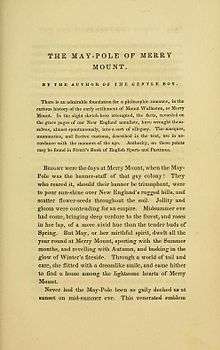The May-Pole of Merry Mount

"The May-Pole of Merry Mount" is a short story by Nathaniel Hawthorne. It first appeared in The Token and Atlantic Souvenir in 1832. It was later included in Twice-Told Tales, a collection of Hawthorne's short stories, in 1837.[1] It tells the story of the colony of Mount Wollaston, or Merry Mount, a 17th-century British colony located in what is now Quincy, Massachusetts.
Plot synopsis
The people of Merrymount, whom Hawthorne calls the "crew of Comus", celebrate the marriage of a youth and a maiden (Edgar and Edith). They dance around a may-pole and are described as resembling forest creatures. Their festivities are interrupted by the arrival of John Endicott and his Puritan followers. Endicott orders for the people of Merrymount to be whipped. Stricken by the newlyweds, he spares them but orders they put on more conservative clothing. He also orders the youth to cut his hair in the "pumpkin shell" style in order to show the Puritan's strictness...
Themes
Endicott and his Puritan followers suppress freedom and individuality, a common theme for Hawthorne. At the beginning of the story "jollity" and "gloom" are said to be contending for an empire, the Merry Mount colonists personifying jollity or mirth and the Puritans being the emblems of gloom. Hawthorne satirizes both parties and the narrative point of view seems to oscillate between them. It is perhaps worth noting that Hawthorne chooses to use "jollity", "mirth" and "gloom" and not "joy", "woe" or "sadness". Real joy, Hawthorne seems to be saying, arises spontaneously out of contrasts. The only time he mentions it is when the youth and maiden suddenly realise that their mirth is visionary and that by truly loving they had subjected themselves "to earth's doom of care and sorrow, and troubled joy, and had no more a home at Merry Mount". The youth and maiden go from being Merry Mounters to, presumably, becoming members of the Puritan community. In this sense it is not clear whether Hawthorne actually sides with the Puritans or the Merry Mount people, or if he is trying to find some middle ground.
By his ambiguous point of view and use of allegory, Hawthorne seems to be trying to focus the readers' attention on the fact that certain aspects of the American past were already shrouded and obscured by myth. It is not too difficult to see the Merry Mounters as the precursors of hippies (Beats, or, perhaps, more accurately free thinkers) or the Puritans as the archetype of the establishment. Hawthorne goes against the tradition of casting America as a promised land where people came to act out their daydreams or to possess it by portraying both the Puritans and the Merry Mounters as a persecuted minority who sought refuge in the new land.
Being a descendant of the earliest arrivals who were seeking freedom over 200 years before, Hawthorne must have known well the stories that typically lie behind official tales, such as those that we find from William Bradford, John Endicott, John Winthrop, and others. His insight about the interplay of personal freedom and family, or civic, responsibility continues to resonate today. As Nathaniel knew then, these matters of choice, such as whether 'strong watter' leads, by necessity, to debauchery or not, are perpetual issues readdressed with each generation.
Stage adaptations
The American poet Robert Lowell adapted this story into one of the three plays in his trilogy The Old Glory, first produced by the American Place Theatre in New York City in 1964. Lowell's version combines parts of this story with another Hawthorne short story, "Endicott and the Red Cross," and with sections from the early American colonist Thomas Morton's book New Canaan.
Howard Hanson's opera Merry Mount is loosely based on the story.
References
- ↑ The May-Pole of Merry Mount Study Guide at What So Proudly We Hail Curriculum. Retrieved 26 March 2012.
External links
| Wikisource has original text related to this article: |